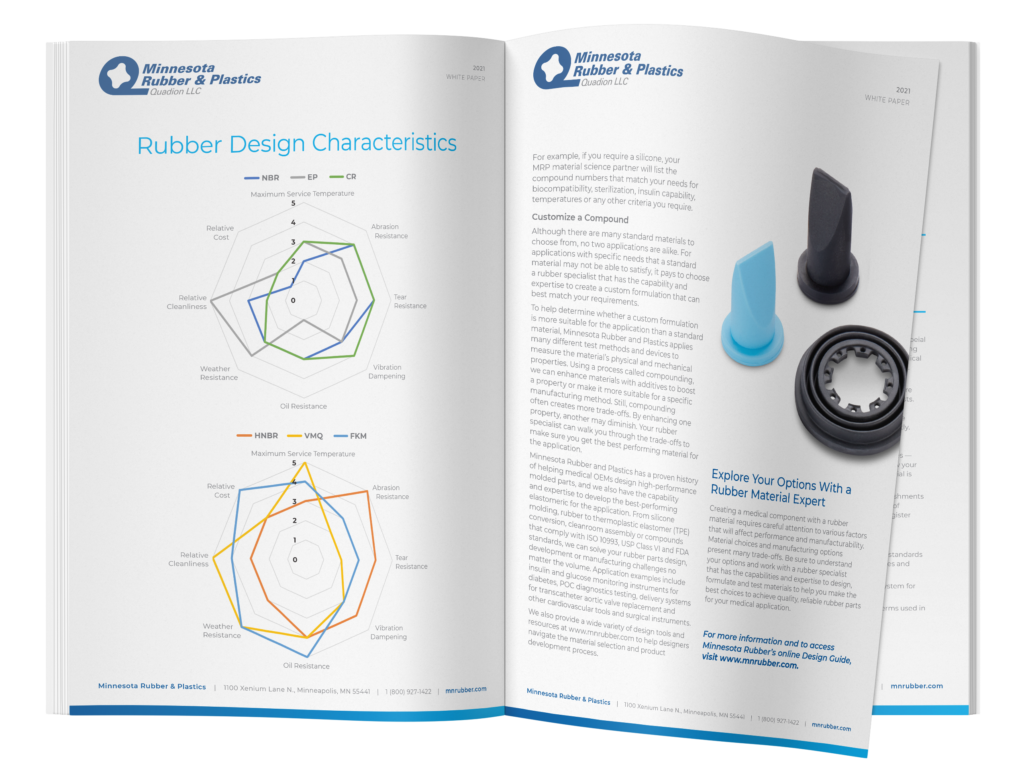When it’s time to design and develop a new medical device that calls for an elastomer component, there are a number of material options and manufacturing processes to consider. The long list of material properties impacting performance includes your prospective polymer’s end-use environment, chemical compatibility, hardness, compression set, tensile properties and manufacturability — to name a few.
Although the selection process may appear daunting, understanding your application, the physical and mechanical properties of your material options and the interaction with mating components will go a long way. These key attributes, along with understanding volume ramp schedules, will drive the proper manufacturing processes to ensure a successful product launch.
In a new white paper, we walk you through some of the factors and trade-offs you’ll need to address when selecting a polymer for your medical component. The paper also describes some of the capabilities that rubber and plastic specialists can provide you to enhance your product development. Some examples are described below.
Cleanliness and Safety Drive Material Needs for Medical Parts
Begin your material selection process by reviewing the product’s design intent, including clinical operation requirements. With any medical part, patient safety and cleanliness play a critical role in the material you choose. Assess where and how your part will be used, as well as any sterilization processes it may encounter. For instance, molded rubber seals are widely used in medical equipment, including implantable devices. Accordingly, you’ll need to know the following about your material:
Biocompatibility. Will the material make contact with skin? Will the product be blood or sterile fluid contacting? Is it intended for either temporary or permanent implantation, the latter of which is considered 10 years or more? Rubber specialists can offer materials that meet USP Class VI standards and materials that comply with ISO 10993 biocompatibility standards.
Sterilization needs. It isn’t enough to ask yourself whether your part will be sterilized. Some materials can’t survive high-temperature steam sterilization and instead undergo ethylene oxide (EtO) sterilization, while others are more suited for the deep penetration of gamma radiation. In addition, chemicals and solvents used for cleaning can cause a part to shrink.
Physical and mechanical properties. As with any rubber part application, you must consider temperature extremes, as well as the stresses your material will undergo that may cause it to stretch, deform or compress.
Understand Your Material’s Physical Properties
In addition to your product’s design intent and clinical operation requirements, it’s important to understand the following physical properties of your material:
Hardness. Hardness is defined as the rubber’s resistance to indentation by a harder object and is an important consideration for critical medical components and seals. Rubber hardness is measured using a Shore durometer — according to ASTM D2240 — and the values are expressed in Shore hardness scale units. Hardness of thermoset rubbers range from 20 Shore A to 90 Shore A, and harder thermoplastic elastomers are categorized as Shore D. However, the most common hardness range is 50 Shore A to 80 Shore A. Your application needs will dictate your required material hardness. For example, sealing products typically use materials with a hardness of approximately 70 Shore A. If your parts will have complex geometries or require deep undercuts, look for a material hardness between 30 Shore A and 80 Shore A.
Material Permeability. When it comes to medical components, a gas or other medium’s ability to penetrate rubber is an important factor in material selection. Components that endure sterilization are vulnerable to moisture incursion, so the material’s permeability must be as low as possible. A material’s molecular size and polarity, the filler material in your compound, your application’s temperature and other factors will determine permeability. To learn more about these and other design factors to consider when selecting a polymer for your medical components, download the full design guide.
